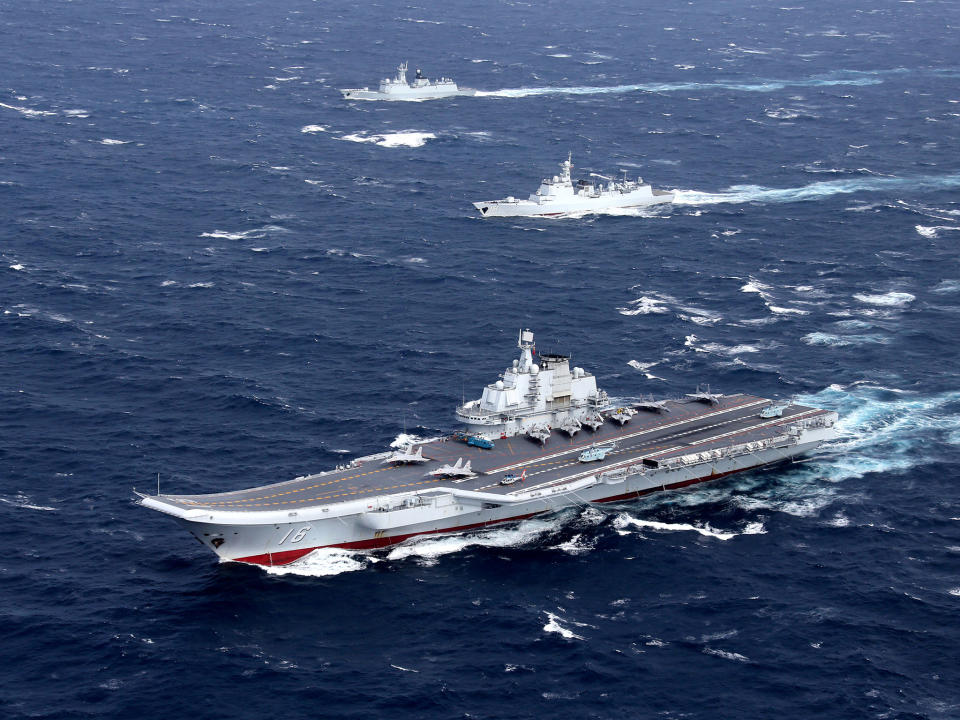An arms race is building between China and its neighbours as the world focuses on Trump and North Korea spat

Japan used to have one of the most powerful aircraft carrier forces in the world, with a fleet of six. The US had seven, but the Imperial Japanese Navy was close to taking delivery of two more, gaining a decisive strategic advantage when the Second World War broke out.
Four years later, the Japanese carrier fleet was at the bottom of the ocean, Emperor Hirohito had signed the surrender document and the Imperial Navy was disbanded. The Japan Maritime Self-Defence Force was later formed, but with strict defensive rules of engagement.
It has now emerged that Tokyo is planning to convert some of its Izumo-Class helicopter carriers into aircraft carriers, the country’s first in 80 years, making them capable of using fixed wing warplanes, probably American F-35 stealth fighters with vertical take-off and landing capabilities.
There has been an immediate reaction from China, with the accusation that acquiring the aircraft carriers and the fighters would breach Article 9 of Japan’s constitution post-war. “We urge Japan to do more that may enhance mutual trust and promote regional peace and stability,” said a foreign ministry spokesman.
But Beijing is also flexing its naval muscles. While the Russian carrier Admiral Kuznetsov was returning home last year after duties in Syria, its sister carrier – former Soviet vessel Varyag, now the Lianonig of the Chinese People’s Liberation Navy – was on manoeuvres in its maiden cruise in the South China Seas, scene of bitter disputes with neighbouring countries.
The concern about conflicts in the Far East has focused on North Korea. But the longer-lasting undercurrent of tension, which may yet lead to hostilities, has been around China and surrounding states that believe Beijing is trying to spread its hegemony in the South China Seas by claiming strings of manmade islands and the strategic waters around them.
Throughout last year, while Donald Trump and Kim Jong-un traded public insults, Beijing has been quietly bolstering its military presence on islands it has been building. Among its seven island bases are three airfields in the disputed Spratley chain. There has been a significant construction drive. Aerial photographs from the Centre for Strategic and International Studies in Washington revealed facilities awash with fortified shelters for warships and artillery and hangers for aircraft and radar. The most advanced base, Fiery Cross Reef, has a 27-acre hinterland of military buildings including underground bunkers and missile emplacement positions.
A few weeks before the news of the Japanese carriers, China announced that it would launch its second aircraft carrier in just over two years, paving the way to start the manufacture of a third. The Ministry of Defence in Beijing declared a breakthrough in aircraft technology which it claimed was the most advanced jet launch system in the world that does not use nuclear power.
Around the same time, as Donald Trump toured the region, the US Navy said it will hold joint drills in the Western Pacific for the first time in a decade with three of its aircraft carriers: The USS Ronald Reagan, USS Nimitz and USS Theodore Roosevelt. Admiral Scott Swift, commander of the US Pacific Fleet wanted to stress: “This exercise is a strong testament to the US Pacific Fleet’s unique ability and ironclad commitment to the continued security and stability of the region.”
But one significant reason for Beijing to feel emboldened has been Mr Trump’s threats to pull US forces out of Japan and South Korea unless there was more money coming from Tokyo and Seoul. There has also been the marked reluctance of his administration to buttress an alliance of China’s neighbours.
“The Trump administration has left other countries in the region unsure of the US, its credibility, its commitment,” says Bonnie Glaser, East Asia analyst at the Centre for Strategic and International Studies. “They wonder where the South China Seas fit in an ‘America First’ world.”
Faced with the unpredictability of Mr Trump, some of China’s former adversaries have now accepted they have to have more amicable relations with the region’s largest nation. Two years ago the Philippines went to an industrial tribunal to challenge Beijing’s claim to more than 85 per cent of the South China Sea and won. But President Rodrigo Duarte has, since then, gravitated towards China and away from the US. Other countries in the region have also moved towards accommodation: Singapore, a staunch ally of the West, agreed last September to Beijing’s request for greater military cooperation.
At the same time countries like Japan, Australia, Vietnam and India (which now has two aircraft carriers), are quietly discussing defence co-operation. Inaugurating the Shangri-la Dialogue, the region’s premier security forum last summer, Australian Prime Minister Malcolm Turnbull said: “In this brave new world we cannot really rely on great powers to safeguard our interests. We have to take responsibility for our own security and prosperity, while recognising we are stronger when sharing the burden of collective leadership with trusted friends and partners.”
The desire to buttress security has accelerated in the intervening months. Robert Emerson, a security analyst, said: “The standoff between the US and North Korea is obviously a dramatic spectacle with two loud leaders providing headlines. What is passing by relatively unnoticed, meanwhile, is the steady militarisation of the region by wealthy and technologically capable states. That is where the long-term dangers of conflict lie.”

 Yahoo News
Yahoo News 